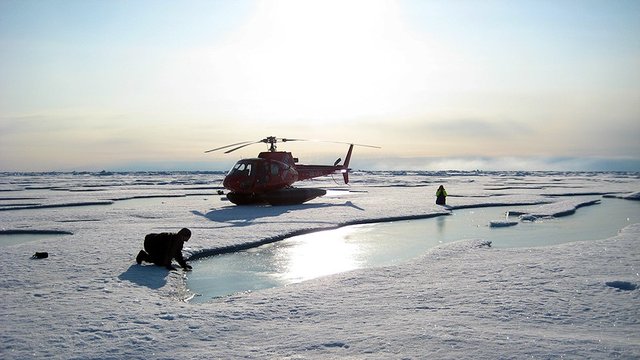Arctic Ice Melt begins
Last Tuesday the summer melt season began in the central part of the Arctic Ocean, when the average temperature north of 80 degrees latitude came above the melting point. This is 1 week later than the average start date and 2 weeks later than in 2012 where the sea ice extent reached an all time low in September.
"The later start date this year increases the likelihood that more of the Arctic sea ice will survive the approximately 3 month long melt season," Rasmus Tonboe from the DMI Centre for Ocean and Ice explains.
"Right now the curve of ice extent in the Arctic is following last years curve. In 2013 the melt onset also came a week later than usual, and 2013 ended with significantly more ice in September than in the record year 2012".
 |
Early melt gives a low September ice extent.
Rasmus Tonboe has looked at the last 35 years of satellite measurements of sea ice in the Arctic Ocean. Here there is a clear correlation between the start date of the melt season in June and the minimum ice extent in September at the end of the melt season.
Others have found a similar relationship between the area of melt ponds on the ice and the September ice extent. Frozen snow reflects more sunlight and thus more energy than melting snow. And frozen snow reflects much more energy than melt ponds on the ice surface.
"When the melt first starts, it accelerates itself by these means" the ice scientist pointed out.
The area of melt water ponds are closely related to how long the ice has melted and thus the melt onset date. The relationship is described in a recent article in the scientific journal Nature (see reference below).
"If the season starts later than the year before, then the ice extent in September will be more than the year before - and vice versa. This is true in 4 out of 5 cases since 1972," says Rasmus Tonboe.
Arctic bathed in sunshine
Among other factors it is the strong solar radiation in June that causes the significant correlation between the start date of the melting and the ice extent at the end of the summer. In fact, the North Pole is the place on Earth that receives most sun shine around midsummer when there are no clouds. Rasmus Tonboe explains.
"Before Sankt Hans (St John’s day) the incoming solar radiation (known as irradiance) is at a maximum in the Arctic. Later in the summer irradiance decreases sharply, both because of thick cloud cover and because of lower solar elevation. In September the irradiance is only 20% of the June irradiance and on 20th September, the sun sets at the North Pole and will be away for the next six months."
You can follow the changing area of sea ice, as well as many other important weather and climate conditions in the Arctic on the Danish Polar Portal. Polarportal.dk is a collaboration between DTU, GEUS and DMI.
David Schröder, Daniel L. Feltham, Daniela Flocco and Michel Tsamados. September Arctic sea-ice minimum predicted by spring melt-pond fraction. Nature Climate Change, vol. 4, maj 2014.
Editing Niels Hansen, kommunikation@dmi.dk
DMI, June 17th 2014.





